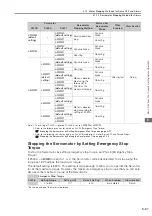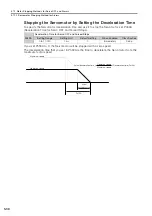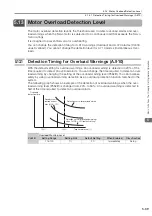
5.14 Electronic Gear Settings
5-41
5
Basic Functions That Requir
e Setting befor
e Operation
5.14
Electronic Gear Settings
The minimum unit of the position data that is used to move a load is called the reference unit.
The reference unit is used to give travel amounts, not in pulses, but rather in distances or other
physical units (such as
μ
m or
°
) that are easier to understand.
The electronic gear is used to convert the travel distances that are specified in reference units
to pulses, which are required for actual movements.
With the electronic gear, one reference unit is equal to the workpiece travel distance per refer-
ence pulse input to the SERVOPACK. In other words, if you use the SERVOPACK’s electronic
gear, pulses can be read as reference units.
Note: If you set an electronic gear in the host controller, normally set the electronic gear ratio in the SERVOPACK to
1:1.
The difference between using and not using the electronic gear is shown below.
•
Rotary Servomotors
In this example, the following machine configuration is used to move the workpiece 10 mm.
•
Linear Servomotors
In this example, the following machine configuration is used to move the load 10 mm. We’ll
assume that the scale pitch of the linear encoder is 20 μm and that the resolution of the serial
converter unit is 256.
Workpiece
Resolution:
16,777,216 (24 bits)
Ball screw lead: 6 mm
When the Electronic Gear Is Not Used
When the Electronic Gear Is Used
To move a workpiece 10 mm:
Calculate the number of revolutions.
The Servomotor will move 6 mm for each revo-
lution, so 10/6 revolutions are required to move
10 mm.
Calculate the required number of reference
pulses.
One revolution is 16,777,216 pulses, therefore
10/6 × 16,777,216 = 27,962,026.66 pulses.
Input 27,962,027 pulses as the reference.
If you use reference units to
move the workpiece when one
reference unit is set to 1
μ
m,
the travel distance is 1
μ
m per
pulse.
To move the workpiece 10 mm
(10,000
μ
m), 10,000
÷
1 =
10,000 pulses, so 10,000
pulses would be input.
Calculating the number of reference pulses for each
reference is troublesome.
Calculating the number of ref-
erence pulses for each refer-
ence is not necessary.
Linear encoder
When the Electronic Gear Is Not Used
When the Electronic Gear Is Used
To move the load 10 mm:
10 × 1000
÷
20 × 256 = 128,000
pulses, so 128,000 pulses are input
as the reference.
To use reference units to move the load 10 mm:
If we set the reference unit to 1
μ
m, the travel
distance is 1
μ
m per pulse. To move the load 10
mm (10,000
μ
m), 10,000/1 = 10,000 pulses, so
10,000 pulses would be input as the reference.
Calculating the number of reference
pulses for each reference is trouble-
some.
Calculating the number of reference pulses
for each reference is not necessary.






























